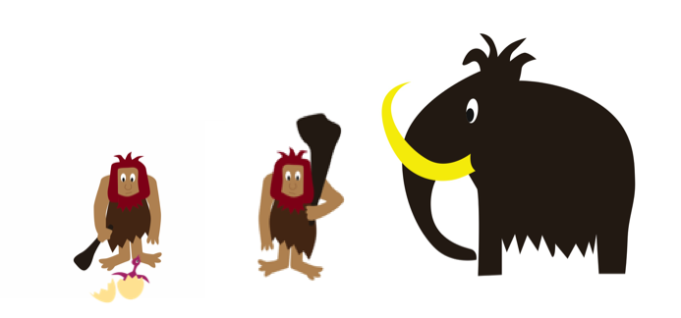
On request, the text provides a short guide to the 7- grade model of causal cognition that was mentioned in the series “Narrative bridging on testing an experience” (links to the series can be found at the end of the text), and where the framework for the model can be found in the publication: “Tracking the evolution of causal cognition in humans” (2017), written by Marlize Lombard, professor in Stone Age archaeology, and Peter Gärdenfors, professor in cognitive science at Lund´s University (see reference and link to the publication at the end).
A quick background, the 7-grade model of causal cognition, has evolved from a group of cognitive scientists who have since the Second World War struggled to remove the behaviouristic traditions that are based on studies of animals and instead replace the behavioristic view with a more cognitively oriented approach. The fact that a framework to study the human mind hasn´t appeared before last year says something about the complexity that surrounds human thinking since the theory of evolution came during the 19th century. But by defining the human as the only species that has developed technology from the tracking of early hunting weapons as stabbing spears, throwing spears, bows, poisoned arrows, snares, etc. Lombard and Gärdenfors have managed to separate the more complex grades of causal thinking of the human from the animals.
From a narrative perspective on construction, the exciting thing about the 7-grade model, which I experienced when using it to describe the narrative from a cognitive perspective in the aforementioned series, is how well the model can be applied to concepts, methods, and terms that concern the human meaning-making. The possibilities the model brings to increase the understanding of how our learning, engagement, and emotions work is also the reason why I would like to encourage others within human interaction and human-computer interaction to explore how our thinking works to understand how beliefs, intentions and desires influence our actions beyond the direct visual agent-object encounter.
If you would like to use the model in your studies/research, see the full publication (linked at the end).
Grade 1: Individual causal understanding
”The first grade involves a direct connection between a perceived force that an individual exerts and the resulting effect. Typical examples are a baby kicking its foot, learning the connection between motor commands and the resulting actions, or a kitten playing with a toy. In this case both the cause and the effect are directly perceived. The result is that the individual experiences its own agency.”
(Gärdenfors, Lombard, 2017, p. 3)
In the example below a caveman has just explored the result from his motor commands and the resulting actions of cracking an egg.

Grade 2: Cued dyadic-causal understanding
”This grade involves two individuals who take turns in performing a similar action. (…) I understand that your action causes an effect because it gives the same result as my action.”
(ibid.)

Grade 3: Conspecific mindreading
”Humans understand how our desires, intentions and beliefs lead to different kinds of actions. (…) I do not perceive the cause of your action, but I use my understanding of your inner state as a hidden variable for the cause of your action.”
(ibid.)
In the case of the fellows below, based on the desires to get more food, we can understand the improvement of a tool as appropriate to the action through mindreading.

Grade 4: Detached dyadic-causal understanding
“Sometimes we do not perceive another’s presence, but only the traces of them. (…) Being able to reason from effects to non-present causes seems to be unique to humans.”
(ibid., p. 4)
Since we have already learned from the previous grades that the cavemen have a certain interest in cracking eggs, we don´t need so much information as to conjure (imagine) causes and forces in time and space to understand traces (see also the examples from ”Part 2, Narrative bridging on testing an experience.”)

Grade 5: Causal understanding and mindreading of non-conspecifics
”We sometimes have a dyadic-causal understanding of the actions and intentions of other species, although their motor actions and cognitive processes are different from ours. (…) The difference, between Grades 3 and 4 on the one hand, and Grade 5 on the other, is gradual and depends to a large extent on the experience of the behaviour of other species. (…) The mapping is a matter of degree, though – we find it easier to read the causal forces in the mind of a chimpanzee or a dog than that of an iguana.”
(ibid., p. 5)
In the example below, depending on the experiences from being hurt the caveman can use a form of empathy mirroring and read the mind of the bird and understand how a bird feels that is hurt (see also ”Part 2 and 3, Narrative bridging on testing an experience”).

Grade 6: Inanimate causal understanding
”This ability to act with accuracy and speed at a distance was then expanded by technologies that allow a more concentrated form of the hitting force, such as the tip of a spear. Spear throwing can therefore serve as an example of well-developed inanimate causal understanding.”
(ibid., p. 6)
Unaware of a new group´s emergence and improvement of weapons and cognitive skills, the cavemen´s days will soon become history.

Grade 7: Causal network understanding
”During this grade of causal understanding, aspects of all the previous causal understanding grades can be integrated and/or mapped onto each other into never-ending patterns of recursion and complexity. (…) With a hypothetical reconstruction of the animal’s activities in mind, trackers can plan ahead and look for animals and/or their signs where they expect to find them.”
(ibid., p. 6)
With a complexity that goes beyond the caveman’s comprehension, someone’s causal understanding of networks will soon become his fate.

If something appears unclear, don´t hesitate to tell.
Katarina Gyllenbäck
Illustrations by Emese Lukács
References:
Gärdenfors, P., Lombard, M., (2017). Tracking the evolution of causal cognition in humans. In the Journal of Anthropological Sciences 95. p.219-234
No animals or cavemen were harmed in the making of this post.

Related readings:
Part 1, Narrative bridging on testing an experience – Distinguishing the stylistic elements.
Part 2, Narrative bridging on testing an experience – The building of a framework.
Part 3, Narrative bridging on testing an experience – Connecting control to a framework.
Recommended readings:
Part 1 Putting into play – A model explaining our causal cognition in design.
Part 2, Putting into play – On narrative from a cognitive perspective I
Part 3, Putting into play – On narrative from a cognitive perspective II
Part 4, Putting into play – How to trigger the narrative vehicle
Part 5, Putting into play – On organizing thoughts and feelings
Part 6, Putting into play – On organizing engaging and dynamic forces
